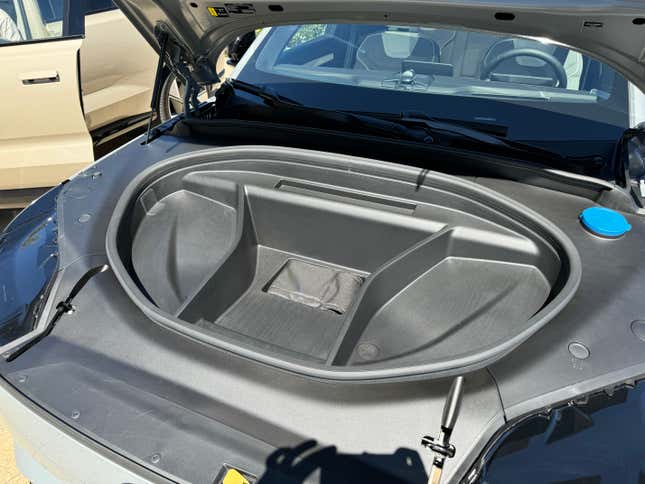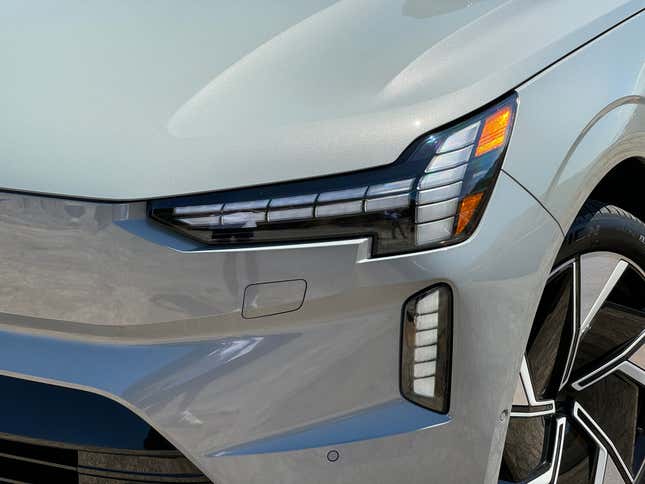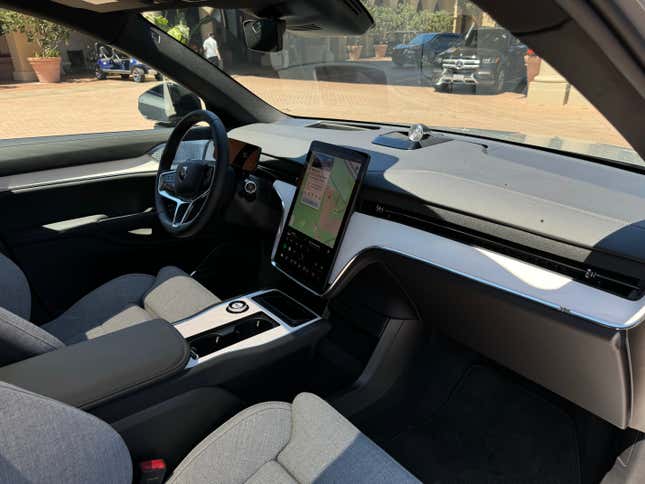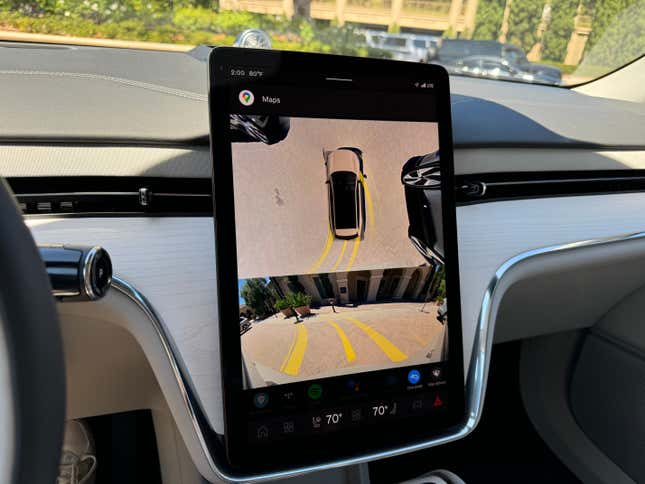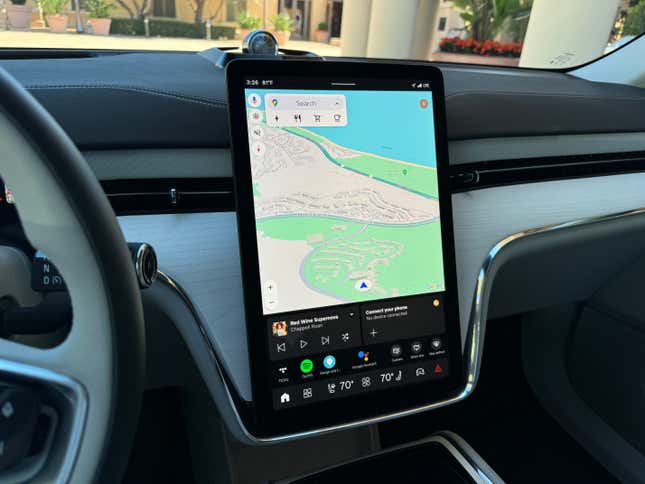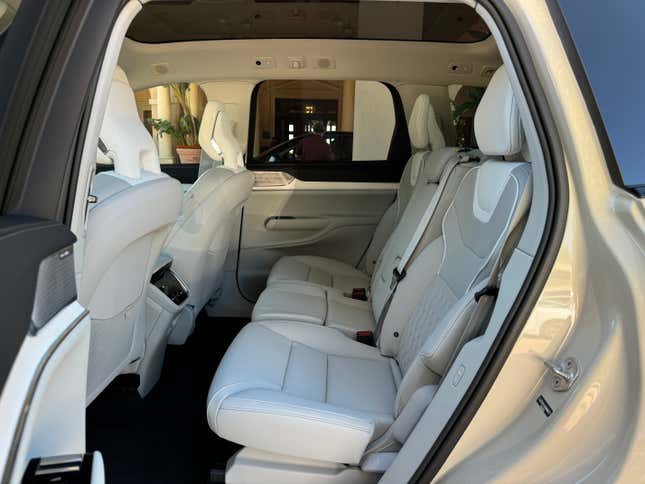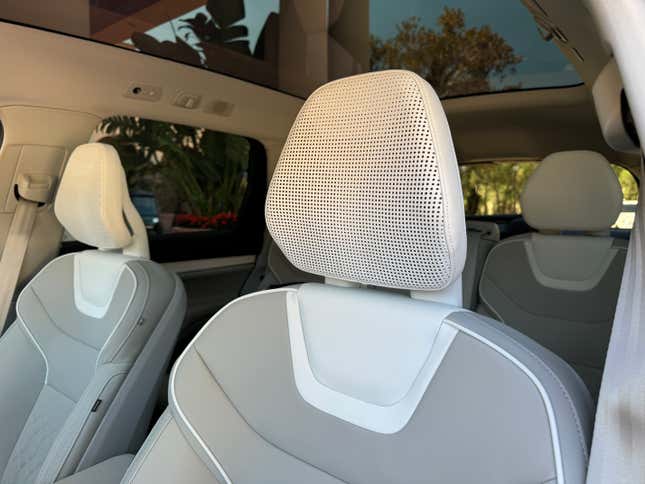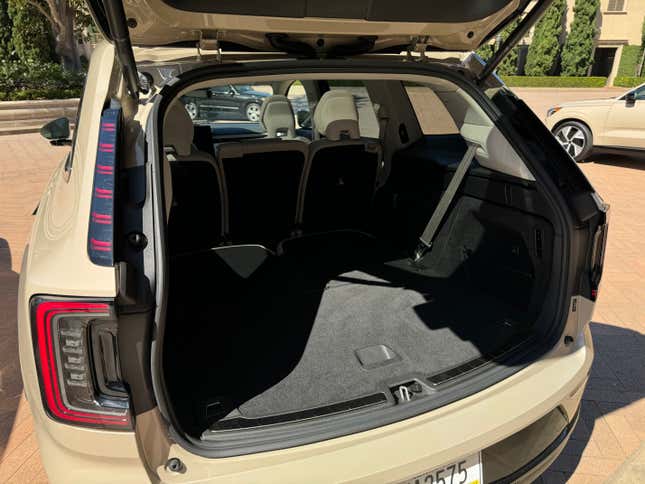Usually the dinner conversation at a first-drive event consists of journalists talking about their favorite features of the new model, what it’s like to drive or how they think it stacks up against the competition. But following our drive of the 2025 Volvo EX90, the brand’s new flagship SUV that’s an electric equivalent to the XC90, all we could talk about was how damn quiet it is.
The EX90 is genuinely one of the quietest vehicles I’ve ever been in — if you were blindfolded, you’d be forgiven for thinking you were riding in a Rolls-Royce. That quietness extends to the EX90’s overall philosophy, from its exterior design to the buttonless cabin layout and the way it drives. This is an extremely nice SUV that, despite some software problems at launch, is already a standout in the luxury EV space.
Full disclosure: Volvo invited me to drive down to Newport Beach to experience the EX90. I was put up in a nice hotel for two nights and fed good meals, including some excellent elote.
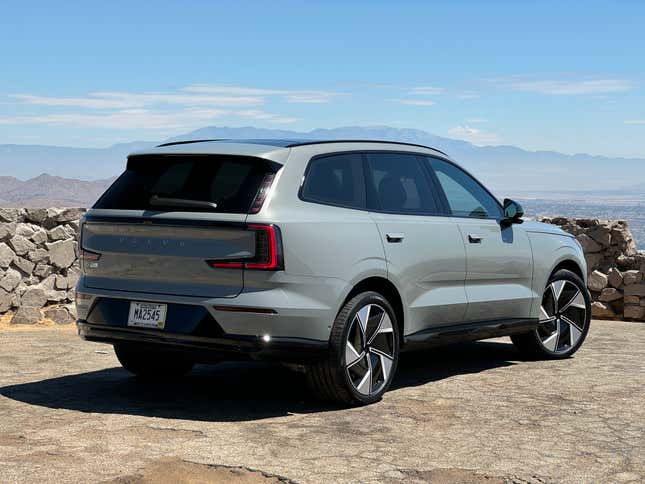
It all starts with the EX90’s new SPA2 platform, which is shared with the Polestar 3. A 111-kWh battery pack (of which 107 kWh is usable) sits low in the floor, and every version of the EX90, at least at first, will have an electric motor at each axle for standard all-wheel drive. The entry-level Twin Motor model has 402 horsepower and 568 pound-feet of torque, but at the drive event in the mountains east of Newport Beach we only get to sample the Twin Motor Performance model that has 510 hp and 671 lb-ft — a lot for a Volvo.
The Performance model will hit 60 mph in 4.7 seconds, a full second quicker than the basic Twin Motor, and while the EX90 certainly feels quick, acceleration is a serene experience. It doesn’t have the same gut-punching immediate torque off the line, instead more gradually building initial speed even if I put my foot down. There’s no electric motor noise or fake engine sounds here, instead just total quietness even as I reach fast highway speeds. Barely any wind, tire or road noise gets into the EX90’s cabin. It really is extraordinarily quiet inside, to a level that I was honestly not expecting, especially not from a car that costs under $100,000.
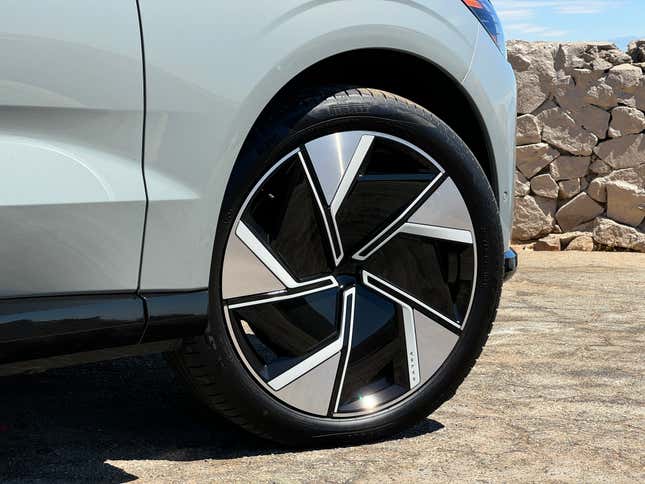
Adding to the EX90’s serenity is its excellent ride quality. Ultra trim levels like the one I’m in get four-corner air suspension with dual chambers and electronically controlled shocks that automatically adjust 500 times per second. 21-inch wheels are standard on the Ultra (20s on the base Plus trim) but my test car has the optional 22s wearing Pirelli Scorpion all-season tires; even with these big wheels the EX90 glides over bumps and rough pavement, never getting unsettled or allowing any bad shudders through. Though not a sporty SUV by any means, the EX90 has nicely weighted steering and stays flat through corners, and you can put the all-wheel-drive system into a Performance mode to give it a more rear-biased setup.
While nothing to write home about in 2024, the EX90’s range, charging and overall efficiency are pretty competitive too. With the 20- and 22-inch wheels, both powertrain variants will have an EPA rating of 300 miles, while EX90s with 21s are rated at 310 miles. In the real world that figure seems easy to achieve over a day of mixed city and freeway driving. The EX90 can be fast-charged at up to 250 kW, good enough for a 10-to-80-percent charge in 30 minutes and can add 111 miles of range in just ten minutes. It’ll also be the first Volvo to offer bi-directional charging, which can be used to power devices or send energy back to your house or the grid.

One of the best parts about driving the EX90 is the regenerative braking. Unlike most other EVs that have one-pedal driving, lifting off the accelerator results in gradual, linear deceleration instead of sharp, immediate deceleration. At first the regen doesn’t seem strong enough to come to a complete stop in the amount of time or distance I’m used to from an EV, but it’s perfectly calibrated — like the acceleration, it’s just a different curve than most other electric cars, again done for the pursuit of serenity. You can put the regen into a middle setting or turn it off completely, but I never would.
The EX90 is the first production car to have a Lidar sensor, a Luminar unit placed in a subtle hump at the top of the windshield, but Volvo isn’t taking advantage of its functionality yet. The driver-assist suite consists of 16 ultrasonic sensors, eight cameras and five radars, eventually allowing for hands-free driving and a number of advanced safety features, but for now you’re stuck with fairly typical adaptive cruise control that has lane-keeping and steering assist but still requires you to have a light touch of the wheel. A first for Volvo is automatic lane changes, but you still have to initiate the move yourself and keep your hands on the wheel, and the system is a lot more sensitive than in cars like BMW and Mercedes that offer similar features. Still, the EX90’s driver-assist systems work well, if overly cautious as you might expect from the safety conscious brand.
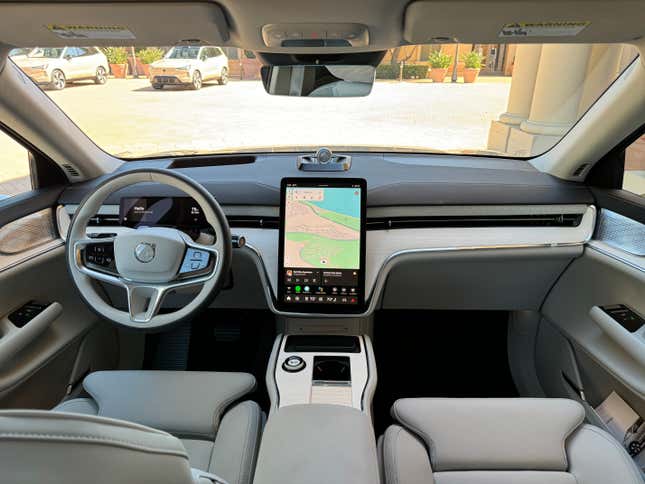
Volvo went with an almost completely buttonless approach to the interior design and user experience, which I find to be pretty successful. In the center of the dash is a vertically oriented 14.5-inch touchscreen running a google-based infotainment system, augmented by a narrow screen in front of the driver. A row of climate controls is always present at the bottom of the center screen, with buttons and widgets above them that are customizable and automatically display frequently used or relevant functions. The system is an improvement over the ones in existing Volvos, both better to look at and easier to use even while in motion. Some functions are buried within submenus, but usually those items are things that owners won’t regularly need to use anyway. The native Google Maps navigation is excellent, though it will require a data package to work, which is free for the first four years. The 360-degree camera quality is surprisingly mid, though.
Lots of people both at the launch and online have complained about the window switches, which are similar to the panned ones in the Volkswagen ID 4, but I don’t find them to be that annoying. Instead of four separate switches, there are just two, with a touch button to switch between controlling the front or rear windows. It’s a pretty obvious cost-cutting measure, but they’re not that difficult to use, and I’m not really an all-windows-down person anyway. How often are you really needing to roll down all your windows super quickly?
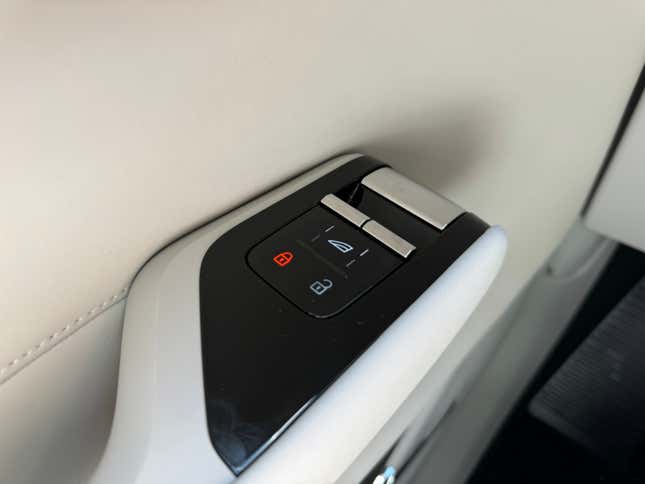
There are some genuine teething issues. While I didn’t experience any software problems with the EX90s I drove, some others on the program encountered glitches and other minor issues with the infotainment system and driver-assist features. Wireless Apple CarPlay and Android Auto will come with a future software update, but you can’t even get the systems through a wired connection yet. Other features missing at launch include the smart charging function, and Volvo has said the car will experience a battery drainage issue that will be fixed with an update. It’s disappointing for a car that’s already coming out later than initially planned, but at the same time I’ve seen new EVs from other brands get quickly, massively improved with OTA updates in ways beyond just fixing bugs.
What was a big problem for me was the phone-as-key functionality. Volvo had an iPhone for each car instead of a physical keyfob (which you have to pay extra for), but instead of a fleshed-out app like what you get from BMW or Rivian, it’s just a card in the Apple Wallet that can lock or unlock the EX90. It only unlocked on the first try maybe a third of the time, and the car frequently didn’t recognize when the “key” was in the car, so it wasn’t able to turn on even after I tried using the NFC connection in the center console. There’s no start/stop button in the EX90, so this meant on multiple occasions I was sitting in the car unable to drive it until the phone was finally recognized.
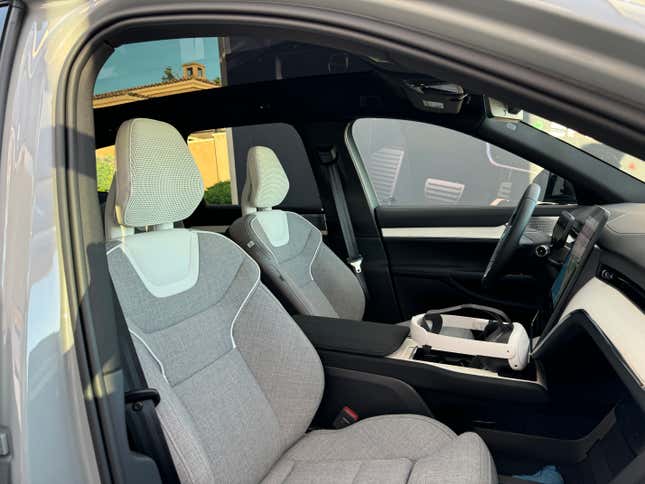
At least the rest of the interior is so freakin’ good no matter how much of a luddite you are. The EX90 I spend the most time in has the optional Tailored Wool Blend upholstery, which is absolutely wonderful. Volvo is known for making some of the best seats in the business and the EX90 hits that mark too, and the plush wool makes them even better. It feels truly luxurious and special, though I wish you could get the rest of the interior to be lightly colored instead of black. You can get the standard Nordico vegan leather in a light Dawn color scheme that’s found on the lower dash, door cards, armrests and other parts of the interior, which really adds to the airy Scandinavian design. A fixed panoramic roof is standard, and despite the lack of a sunshade I didn’t find it to let in too much light or heat.
I really love the Light Ash wood trim on the dash, doors and center console, and at night the ambient lighting is illuminated through the thin wood panels. All of the metal bits look and feel nice too, but while the Nordico feels pretty good in some spots, parts of the cabin could do with more padding, and the steering wheel feels pretty cheap. A premium interior option with a more liberal use of high-end materials would be welcome, but the EX90 does feel worth its pricetag. Another interior standout is the optional $3,200 Bowers & Wilkins sound system that has 1,610 watts of power and 25 speakers, including a tweeter in the dash and speakers in the headrests, plus Dolby Atmos capability. It’s a truly great system that’s amplified in its greatness by how quiet the car is.
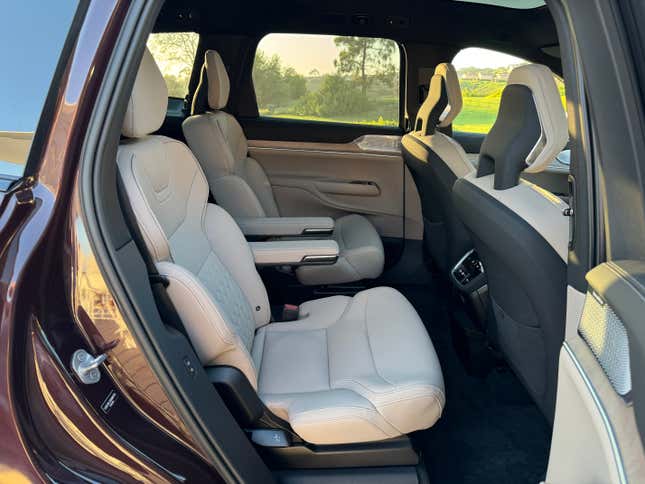
Looking at it as a practical three-row SUV the EX90 is a success, which really is the most crucial part. It has a ton of storage space beneath the center screen, a well-placed wireless charger and large-enough cupholders in the center console. The door cards have a good amount of space, The back seat is spacious and easy to step in and out of, and it’s a breeze to slide, recline or fold the second row of seats to get into the third row. My 5-foot-9 self fits well in the third row, despite the seat bases being mounted much higher than the second row’s, and there are USB-C chargers, climate vents, cupholders and more storage cubbies. A three-across bench is standard, but for an extra $500 you can opt for a pair of captain’s chairs in the second row, which get adjustable armrests that feature some of the coolest cupholders I’ve seen in a while.
Even with the third row up the EX90 has 10.9 cubic feet of cargo space, with 2.2 cubic feet available under the load floor. There are buttons in the rear to quickly fold the second and third rows up or down, which creates a totally flat load floor. The EX90 has 23.1 cubic feet of space behind the second row and 67.6 cubic feet behind the first row. I need to put a disclaimer on those specs, though — Volvo says all of these cargo space figures are “under the load cover,” instead of measuring the total available space, so I can’t give a proper comparison to other cars, but it certainly felt comparable enough to the Rivian R1S and Mercedes-Benz EQS SUV. There is a frunk, but it only has 1.2 cubic feet of irregularly shaped space.
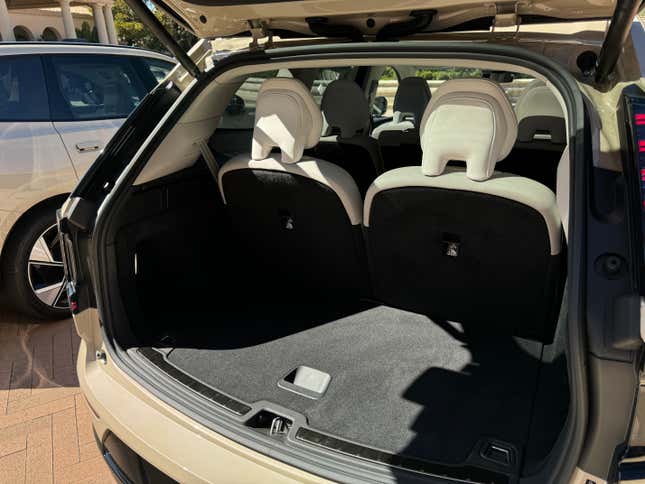
The EX90 Plus starts at $81,290 including destination, getting you features like a head-up display, Bose sound system, a cabin air purifier, four-zone climate control, a heat pump and all of Volvo’s safety tech. The Ultra trim costs $85,640, adding things like wonderful massaging seats, soft-close doors, laminated rear windows and the air suspension. On both trims, the Performance powertrain is $5,000. That makes the EX90 slightly pricier than the Rivian R1S, which is not as nice to spend time in, and a lot cheaper than the Mercedes EQS, which is larger and even more tech-heavy. Kia’s EV9 is more affordable and spacious, but the EX90 easily has it beat on the luxe front.
Volvo already started production of the EX90 at its plant in South Carolina, which means it’ll avoid any EV tariffs, though it’s too expensive to get the federal tax credit. That factory currently also builds the S60, and Volvo says it has a capacity of up to 150,000 cars per year. Hopefully Volvo really can work out the EX90’s software problems quickly, but even in its current state the EX90 is one of the nicest luxury SUVs out there, electric or not.
